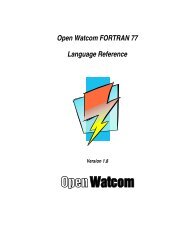Relocatable Object Module Format (OMF) Specification
Relocatable Object Module Format (OMF) Specification
Relocatable Object Module Format (OMF) Specification
You also want an ePaper? Increase the reach of your titles
YUMPU automatically turns print PDFs into web optimized ePapers that Google loves.
<strong>Relocatable</strong> <strong>Object</strong> <strong>Module</strong> <strong>Format</strong><br />
The Communal Length field is a single numeric field or a pair of numeric fields (as specified by the Data Type<br />
field), encoded as follows:<br />
Value Range<br />
Number of<br />
Bytes Allocation<br />
0 through 128 1 This byte contains the value<br />
0 to 64K-1 3 First byte is 81H, followed by a 16-bit word whose value is used<br />
0 to 16 MB-1 4 First byte is 84H, followed by a 3-byte value<br />
-2 GB-1 to 2 GB-1 5 First byte is 88H, followed by a 4-byte value<br />
Groups of Communal Name, Type Index, Data Type, and Communal Length fields can be repeated so that more<br />
than one communal variable can be declared in the same COMDEF record.<br />
Notes<br />
If a public or exported symbol with the same name is found in another module to which this module is<br />
bound or linked, certain linkers will give the error "symbol defined more than once.“<br />
Communal variables cannot be resolved to dynamic links (that is, imported symbols).<br />
The records are ordered by occurrence, together with the items named in EXTDEF and LEXTDEF<br />
records (for reference in FIXUP subrecords).<br />
In older linkers, object modules that contain COMDEF records are required to also contain one<br />
COMENT record with comment class 0A1H, indicating that Microsoft extensions to the Intel object<br />
record specification are included in the object module. This COMENT record is no longer required;<br />
linkers always interpret COMDEF records.<br />
Example<br />
The following COMDEF record was generated by Microsoft C Compiler version 4.0 for these public variable<br />
declarations:<br />
int var; /* 2-byte integer */<br />
char var2[32768]; /* 32768-byte array */<br />
char far var3[10][2][20]; /* 400-byte array */<br />
The COMDEF record is:<br />
0 1 2 3 4 5 6 7 8 9 A B C D E F<br />
0000 B0 20 00 04 5F 66 6F 6F 00 62 02 05 5F 66 6F 6F . .._var.b.._var<br />
0010 32 00 62 81 00 80 05 5F 66 6F 6F 33 00 61 81 90 2.b...._var3.a..<br />
0020 01 01 99 ...<br />
Byte 00H contains 0B0H, indicating that this is a COMDEF record.<br />
Bytes 01-02H contain 0020H, the length of the remainder of the record.<br />
Bytes 03-0AH, 0B-15H, and 16-21H represent three declarations for the communal variables var, var2, and var3.<br />
The Microsoft C compiler prepends an underscore to each of the names declared in the source code, so the<br />
symbols represented in this COMDEF record are _var, _var2, and _var3.<br />
Tool Interface Standards (TIS) <strong>OMF</strong> <strong>Specification</strong>, Version 1.1 53
















